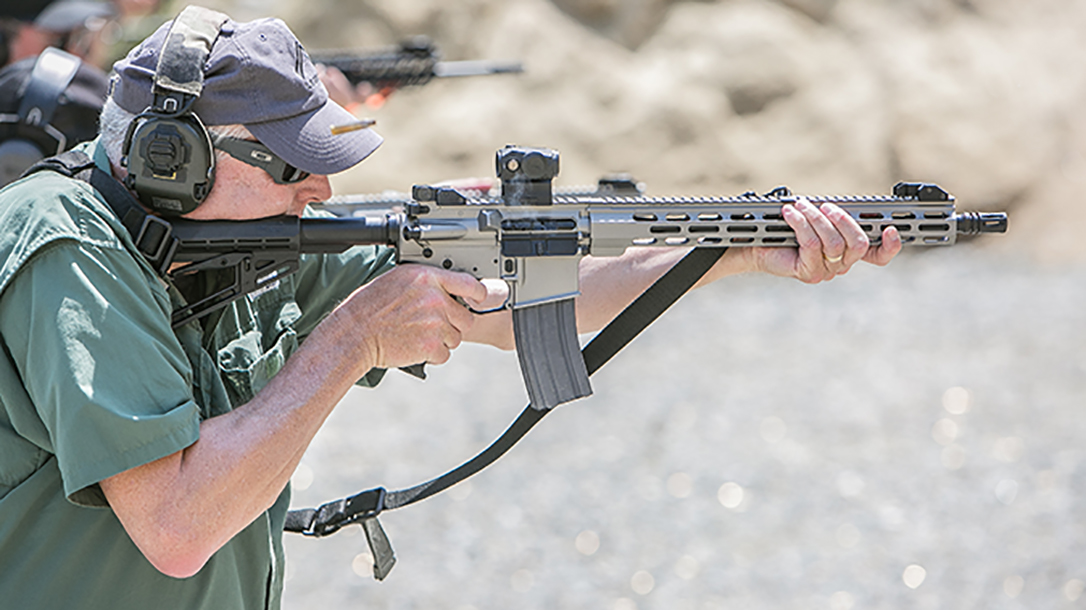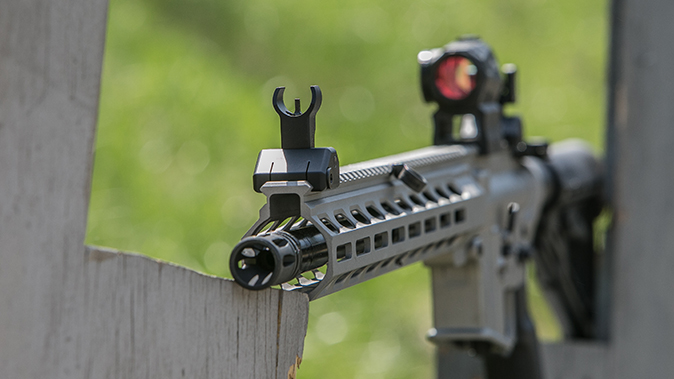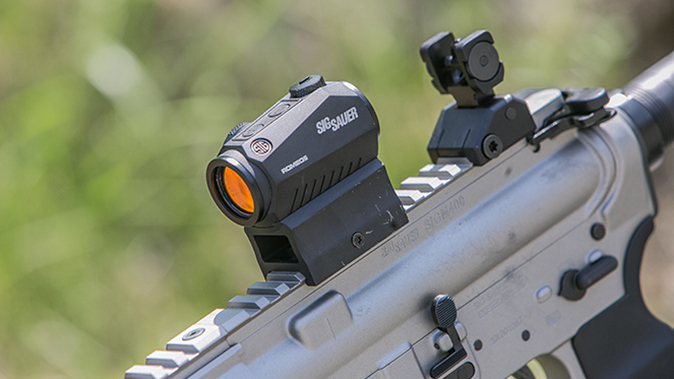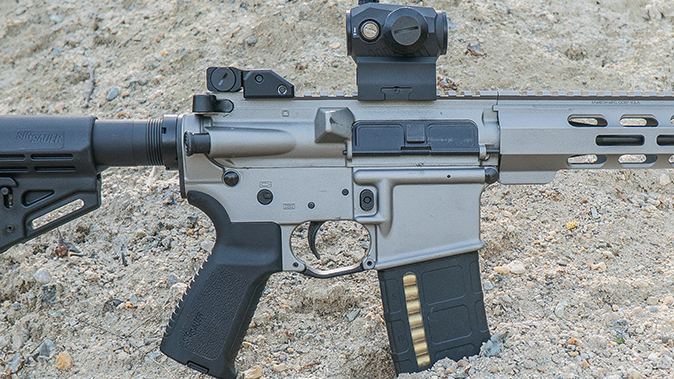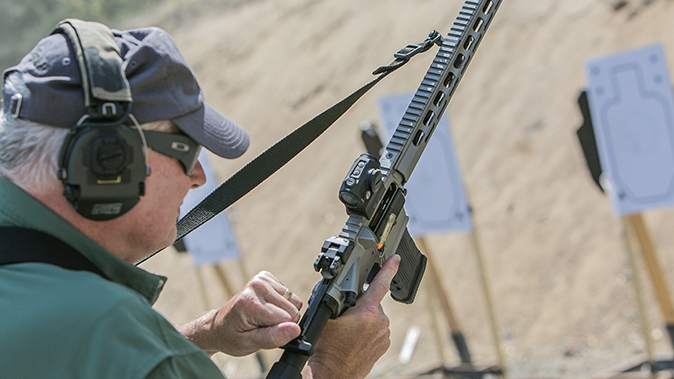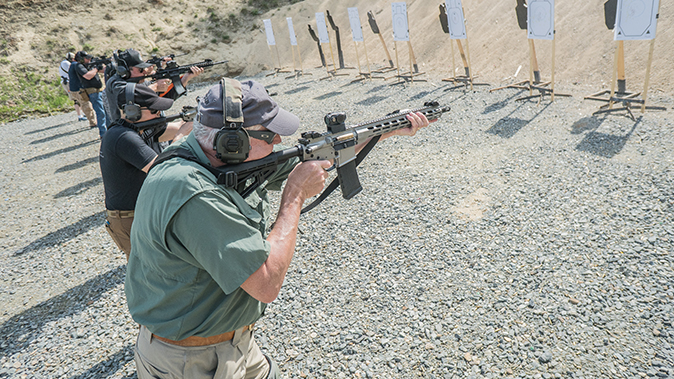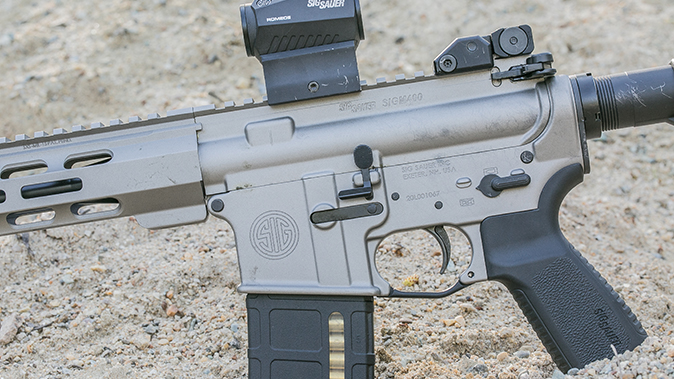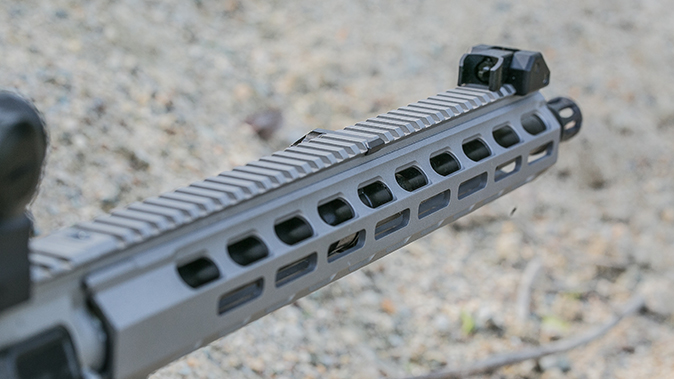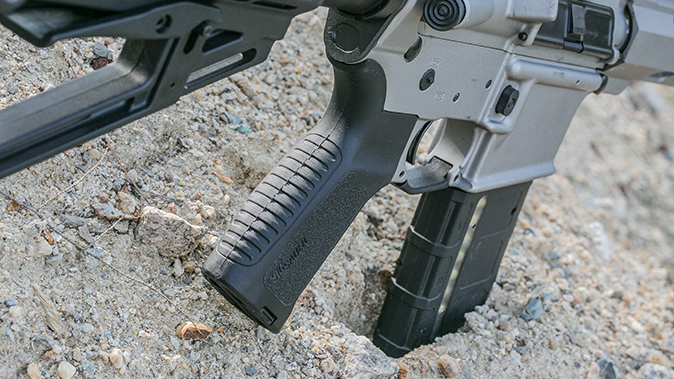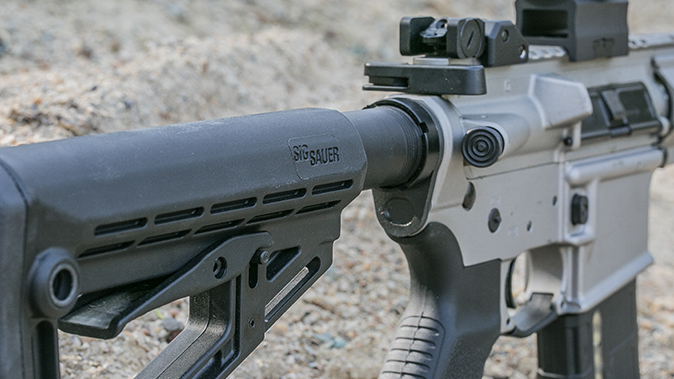I think it’s fair to say that Sig Sauer has become the leader in the U.S. firearms industry in the past five or so years. The company has had hit after hit in the commercial, law enforcement and military communities. In 2015, I evaluated the new Sig P320 pistol and its adoption by the Oklahoma Highway Patrol, the first major law enforcement agency to do so. Since that time, the P320 has been adopted by the Department of Homeland Security, numerous other law enforcement agencies and, most noticeably, the U.S. Army. In addition, the Sig MCX has been fielded by members of the U.S. special operations community as well as British law enforcement units.
While the modular, piston-driven MCX has garnered the majority of the attention, the Sig M400 has been a solid performer since its introduction in 2010. The M400 series of rifles represents Sig’s family of traditional direct-impingement rifles built around the original M4/M16 design. Currently, the M400 is available in several models, with the newest being the M400 Elite. I recently had an opportunity to visit Sig’s headquarters and manufacturing facility in Exeter, New Hampshire, for an exclusive preview of the new rifle.
First Impressions
During the visit, I was able to tour the plant and sit down with Jordan Hunter, Sig’s marketing director. Each part of the plant represented a production cell and, as expected, the organization and flow was well thought out. I did not see a single metal shaving, drop of oil or piece of debris on the floor—you could have almost eaten off of it. I did notice a large pipe that ran across the ceiling for the entire length of the building. It turns out that this serves as a 100-yard test range.
Advertisement — Continue Reading Below
Hunter explained that after launching the initial M400 series of rifles, Sig decided to introduce a version of the M400 that, while being loaded with features, would be less expensive that existing carbines. The M400 Elite has an MSRP that is approximately $300 or so less than the M400 Classic model. But there are more similarities than differences. The M400 Elite is based on the same quality upper and lower receivers as the standard M400. The difference is that the Sig M400 Elite does not feature ambidextrous controls. It also has an enhanced mil-spec trigger and internal components that have been coated with a diamond-like carbon (DLC) finish for a smoother trigger pull.
Part of the price savings comes from the elimination of the iron sights on the basic M400 Elite. For many users, the need for iron sights has become less important with today’s reliable reflex sights. In addition, backup iron sights come in a variety of designs, and each shooter has his or her preferences. Of course, Sig does offer the M400 Elite with one of the company’s ROMEO5 red-dot sights for only $159 more.
Advertisement — Continue Reading Below
The M400 Elite has the same cold-hammer-forged, 1-in-7-inch-twist barrel found on other 5.56mm NATO Sig rifles. The barrel floats freely inside an ultra-light M-LOK handguard with Sig’s own Micro-Light gas block, which is extremely low profile and makes for a very soft-shooting carbine.
Sig has also designed its own furniture for this carbine. The M400 Elite features an enhanced pistol grip as well as a six-position-adjustable buttstock with left- and right-side QD sockets as well as three slots for mounting a loop/buckle-style sling. A rubber recoil pad ensures a positive mounting surface. The rubber pistol grip is textured on the sides with groves on the front- and backstraps for traction. A storage compartment is accessible from the bottom of the pistol grip. Finally, the M400 Elite is available with either a black or titanium finish. I chose the latter for my test rifle.
As mentioned, Sig offers an M400 Elite package that includes a ROMEO5 red-dot sight, and I got to test a model in such a configuration. The ROMEO5 is a robust, yet economical sight that features a 2-MOA dot with 10 illumination settings. Two of the settings are compatible with night-vision optics. The ROMEO5 is powered by a single CR2032 battery that provides 50,000 hours of operation. The ROMEO5 also features Sig’s Motion Activated (MOTAC) illumination technology. This power-saving feature put the unit to sleep after two minutes of being motionless and wakes the sight up when it senses movement. In short, the ROMEO5 offers a lot of features at a fraction of the cost of other red-dot sights.
Advertisement — Continue Reading Below
Back To School
For the second day of my trip to Exeter, Jordan Hunter had arranged a one-day carbine course at the Sig Sauer Academy. With over 25 ranges and constantly expanding, the Academy has become a central training hub for the northeast. It offers an extensive curriculum for civilians and military/law enforcement personnel. The Academy also has a very well-stocked pro shop that I availed myself to and put a good lick on my credit card.
The one-day Rifle 102 course is focused on basic skills, proper manipulation and practical applications of the carbine. Along with equipment selection, the course covers loading/reloading, malfunction drills and multiple target transitions. The instructor for the course was Dan Hunt, who has an extensive military background and has instructed numerous foreign military units in tactics and marksmanship. The first hour or so of the class was spent in the classroom, taking care of the obligatory paperwork and reviewing the fundamentals of the course. The class represented a cross-section of the shooting community, with many in attendance being regulars at the Academy.
We spent the entire day on a 50-yard range, focused more on positions and manipulations than precise marksmanship. I zeroed the ROMEO5 in less than five rounds and proceeded to shoot a respectable group. The one change I made to the rifle was to replace the standard sling with a Blue Force Gear Vickers Combat Applications Sling (VCAS) from the pro shop. I have been running the VCAS exclusively for over five years on all of my rifles. I just wasn’t going to have a good day with the standard non-adjustable sling that comes on the M400 Elite! The VCAS solved all of my issues, and the sliding adjustment buckle made for easy transitions.
Advertisement — Continue Reading Below
For the rest of the day, the drills and exercises built on one another as they became progressively more challenging. I found the diameter of the M-LOK handguard ideal, and the Sig pistol grip and stock worked well. The ROMEO5 sight proved exceptional for the course and may well be one of the best values on the market today. The trigger, while a little heavy, was much better than a stock mil-spec unit, and it only got better as I put more rounds downrange. We ran about 300 rounds of 55-grain FMJ ammo through the M400 Elite without any issues.
More Testing
After I returned home, Sig shipped me the M400 Elite I used in the class for further evaluation. The company also sent me one of its 1-4x24mm TANGO4 scopes for evaluation. The TANGO4 is designed for CQB to mid-range engagements and features a first-focal-plane illuminated reticle and LockDown zero-stop turrets. My test sample was equipped with a horseshoe-dot reticle that proved to be very fast for engagements out to 300 yards.
Advertisement — Continue Reading Below
On the range, I tested the M400 Elite with a variety of loads. Prior to installing the scope, I shot a couple of boxes of Hornady’s 55-grain FMJ-BT training ammo with the ROMEO5. Designed to complement Hornady’s 55-grain TAP/V-MAX ammo, this is a steel-cased load that is both economical and consistent. With a 50-yard zero, the M400 Elite produced several groups tighter than 2 inches at 50 yards. Considering I had no magnification with the ROMEO5, I was impressed. I then consistently engaged plates out to 300 yards.
To see the full accuracy potential of the M400 Elite, I installed the TANGO4 and went to work at the 100-yard line. I did find that the horseshoe-dot reticle, combined with the 4X magnification, made keeping a consistent point of aim somewhat difficult. The Hornady 55-grain FMJ-BTs averaged 2,799 fps and produced a 2-inch group, while the 55-grain V-MAXs averaged 2,795 fps and produced a 1.75-inch group. Hornady also provided its new 62-grain Black FMJs, which averaged 2,905 fps. A five-shot group with this load measured 1.6 inches, with three rounds touching. Aguila’s 62-grain FMJs averaged 2,960 fps and produced a group that measured 1.8 inches. Had I done my part, the group could have been smaller since three of the five rounds produced a 0.5-inch group.
I then ran the gun on steel plates out to 400 yards, and its cold-hammer-forged barrel really shined here. The M400 Elite particularly liked the Aguila 62-grain FMJs when reaching out to 300 yards and beyond.
Advertisement — Continue Reading Below
Looks & Performance
While the M400 Elite is built to perform, I would be remiss not to mention the new titanium Cerakote finish. I visited Sig Sauer prior to any formal announcement of the M400 Elite being made. When I showed up at the Academy for the class, the rifle immediately garnered the attention of staff and students alike. The color was the first detail that drew my eyes to the rifle, followed by the new Sig furniture.
I came away impressed with the quality, features and value that come with the M400 Elite. To quote Tom Taylor, Sig’s vice president of commercial sales, “For 2017, we wanted to once again raise the consumer expectation by delivering an accuracy-driven rifle that comes equipped with all the desirable features that shooters look for in a complete AR system.”
The M400 Elite delivers on all counts, and Sig’s commitment to the gun world is second to none. Just look at all the new products the company has unveiled over the past few years.
Advertisement — Continue Reading Below
Sig Sauer M400 Elite Specs
| Caliber: 5.56mm NATO |
| Barrel: 18 inches |
| OA Length: 32-35.2 inches |
| Weight: 7.3 pounds (empty) |
| Stock: Collapsible |
| Sights: Sig Sauer ROMEO5 |
| Action: Direct-impingement semi-auto |
| Finish: Titanium Cerakote |
| Capacity: 30+1 |
| MSRP: $1,359 |
Sig Sauer M400 Elite Performance
| Load | Velocity | Accuracy |
|---|---|---|
| Aguila 62 FMJ | 2,960 | 1.80 (Average), 0.50 (Best) |
| Hornady 55 FMJ-BT | 2,799 | 2.00 (Average), 1.00 (Best) |
| Hornady 55 V-MAX | 2,795 | 1.75 (Average), 0.80 (Best) |
| Hornady 62 Black FMJ | 2,905 | 1.60 (Average), 0.75 (Best) |
For more, visit sigsauer.com.
